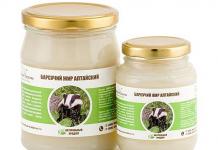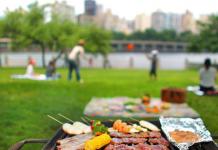Now we will look at how to draw a landscape with a pencil step by step for beginners. It will have a palm tree, a bank and a river. This lesson is for beginners and is aimed at consolidating knowledge of the technique of drawing hatching. If you don’t know the basics, then you need to learn first, then.
We draw a sketch of the landscape.
Below is a table in which the different shading tones are shown by number.

See what and what type of hatching we will draw. Each paragraph in brackets will indicate the number, which tone to use.

Use pencils of different softness to create a specific tone to create strong contrast. The author begins by applying light colors (1) to the sky and water with a 2H pencil. 
Make diagonal strokes from the upper part of the sky (2), make the bottom of these lines lighter by weakening the pressure on the 2H pencil. Doing horizontal shading in the foreground of the water (2) creates the illusion of ripples. Remember to remove the horizontal horizon line in the island before starting hatching. 
Shade the farthest mountain (coast) (3), which is in the distance, with an HB pencil (press lightly on the pencil). Near the island (in which we had to erase the line) we make shadows with HB and 2B pencils, and hatch a small part of it in the foreground with 2B and 4B. Light colors (4) of the island are made with HB pencil. Do not hurry. If you start to get tired or feel frustrated, take a break. When you return to the lesson, you will look with fresh eyes and can correct what you were dissatisfied with.

Using an HB pencil, draw a reflection of the island in the water (5). We use the tone darker than the island itself at this stage. Make the hatching lines horizontal, not at an angle. You may find it easier to add hatch lines by turning the drawing (sheet) sideways. We paint over the ground in the foreground (7), strokes we do 2B with a pencil. The author writes that this style of sketching is currently her favorite. However, you are a unique person with your own preferences. Those. you need to experiment with different drawing techniques until you find the style that suits you best! 
Use a 4B pencil to draw some squiggles in the foreground. These lines will mimic small shrubs and foliage. We draw the trunk.

Add 2B pencil strokes along the bottom of the island (6). In the upper part of the island there are light areas, darker below. The author has left a tiny horizontal streak of light where earth meets water. She also used a sharpened HB pencil to draw some small trees and bushes on the island. Draw the branches of the palm tree 2B with a pencil.

Use sharpened HB and 2B pencils to draw small branches on the top of the palm tree. The branches in the foreground are much darker than those farther away.

Move away from the drawing and look at the hatching. You may need to make some areas lighter or darker. To make it darker, just add extra lines between the other hatch lines. To make it lighter, take a soft elastic band and walk gently. Sign your name, write the date, and put aside the drawing with a smile.

Don't be afraid to use different shading methods. You should not draw in a way that you do not like, problems may arise later, you need to look for new methods. If you have made even a very terrible drawing, you can repeat the approach again! Keep in mind that the more you practice sketching, the faster and better you will get. On a good day, you can draw some different and wonderful sketches within an hour!
Author: Brenda Hoddinot, website (source)
How to draw autumn with colored pencils
Drawing master class. Landscape "Native expanses"
Kokorina Elena Yuryevna, teacher of fine arts, Municipal Educational Institution Slavninskaya Secondary School, Tver Region, Torzhok District.
Purpose of work: the master class is intended for children of middle and senior school age, teachers of fine arts and teachers of additional education. It can also be used in classes with younger children, if you offer them a ready-made drawing.
You can decorate the interior with a drawing, or use it as a gift, as well as to participate in competitions and exhibitions.
Target: execution of an autumn landscape with colored pencils on the theme "Native expanses"
Tasks:
- draw an autumn landscape with colored pencils;
- to contribute to the development of the creative imagination of children, the formation of the ability to convey their observations and experiences in drawings;
- to form the ability to see beauty in the phenomena of reality of the surrounding world of the native land;
- to develop an interest in landscape painting and in the drawing process itself.
For work we need: a sketchbook, a set of colored pencils, a black helium pen or pencil.

... If you see a river in the picture,
Or spruce and white frost, or a garden and clouds,
Or a snowy plain, or a field and a hut,
The picture is necessarily called - landscape.
A landscape painting allows the artist to express his attitude to the world in a broad sense, to the natural world that surrounds us. Nature brings people closer together, often gives them similar moods, thoughts and experiences.
How beautiful are the beloved open spaces,
The blue was given a calling spill,
The rustle of grasses and birches are dear to me,
Memory with tenderness in the heart keeps!(Oleg Mandrakov)
Our nature-beauty often changes outfits.
I love you native open spaces,
the green of the forest and the smell of the fields,
blue lakes, majestic mountains,
the many-sidedness of my Russia.
And dawn among curly birches,
and the sunset by the river is blue
the noise of acacias and tired maples.
I'm happy to live on the sidelines dear.
Spring waters are pouring
il is spinning golden leaf fall.
All the freaks of nature are good,
I enjoy any weather.(Alexey Luchinin)
Golden autumn - joyful, magnificently harvested, rich in harvest, they love it for its generosity, for the wealth of fields, gardens, for clear days, azure-blue sky, for the beauty of forests painted with gold and crimson paint.
Today I propose to draw an autumn landscape with colored pencils. The main characters of our landscape will be birches on the river bank, and in the background - a church.
To begin with, let's make a sketch of the main plot of the future picture. You can use a simple pencil, but I took a helium black pen.

With a blue pencil, we begin to tint the sky and the river. We put the strokes horizontally.

With a darker blue pencil, change the direction, put the second layer of hatching.

We introduce a purple pencil into the sky and the river, at the same time paint over the trunks of birches.

With a yellow pencil, we start drawing the crown near the birch. Put the strokes horizontally.

Paint the ground under the birch, the nearby hill on the opposite bank and two trees in front of the church with yellow.

With a brown pencil we shade the leaves in the crown of birches. We put short strokes in different directions. We slightly introduce the same color into the river under the birch and under the trees near the church.


We introduce green into the crown of the birch.

With a burgundy-brown pencil, paint over the distant hill and introduce this color into the river under the birch.

With a dark green pencil, draw the foliage of the bushes, tall grass along the river bank and paint over the foreground of the bank where birches grow.

Draw blades of grass with a brown pencil. We put the shading in different directions - this creates the feeling of swaying grass. We also emphasize the tops of the hills with shading.


We put light brown shading behind the birches.

We draw a drawing on the trunks of birches in black pencil.



We introduce black strokes into the crown of birches.


With a green pencil, we do the mesh shading in the background, behind the birches, and paint over the black background.

We make burgundy spots.

We introduce the red pencil into the foliage of the bushes.

We paint the church and the trees in front of it.


We paint the river: with a light blue pencil we make horizontal and vertical strokes. Paint over the space unevenly to create a feeling of water movement.



In the background, behind the birches, draw the spruce in black pencil.


Now, with wide strokes, paint over the entire crown of birches with a yellow pencil. And we introduce the same color into the river.

I'll take a pencil, draw a forest
I will draw the fields and the snake of the river.
To have peace and quiet on this Earth ... (Terenty Travnik)
The drawing is ready, but at the very beginning, for the sketch, I used a helium pen. In some places in the drawing, the drawing line comes to the fore. I suggest smoothing out these transitions. To do this, using the same black pen, we will emphasize with shading the drawing on the trunks of birches and the striking line of the river.
Drawing landscapes with colored pencils is fun and creative. Having mastered the features of creating such drawings, later you can easily transfer your impressions of the beauty of the surrounding nature onto a sheet of paper. This detailed master class for aspiring artists teaches you the basics of painting a landscape with colored pencils step by step, allowing you to take the first steps towards making your dream of creating wonderful landscape drawings come true.
Materials used
To draw this drawing of a beautiful mountain landscape, you need a minimum of materials, namely:
- graphite (simple) pencils No. H; # 2B;
- colored pencils (preferably more than 24 colors in a set);
- eraser
How to draw a landscape with colored pencils: a step-by-step guide
1. Make a sketch with pencil # H: without being distracted by the details, outline the location of the main objects on the sheet. The lines should be only slightly visible.
 The photo shows a sketch image processed in a photo editor in order to better consider the basic principle of work at this stage. Only the boundaries of objects in the near, middle and background are indicated.
The photo shows a sketch image processed in a photo editor in order to better consider the basic principle of work at this stage. Only the boundaries of objects in the near, middle and background are indicated.
 2. With a 2B lead pencil, make the sketch more detailed: draw stones in the foreground, cracks in the rock in the middle ground and outline the shaded areas.
2. With a 2B lead pencil, make the sketch more detailed: draw stones in the foreground, cracks in the rock in the middle ground and outline the shaded areas.
 3. Blend the shadows to get rid of the lines of the lead pencil.
3. Blend the shadows to get rid of the lines of the lead pencil.
 4. Use a yellow pencil to fill in all the sunlit areas of the landscape (except water).
4. Use a yellow pencil to fill in all the sunlit areas of the landscape (except water).
 5. In light blue, paint shadows on the rocks in the foreground. Without clicking on the pencil, fill the sky and water with blue. The strokes should be invisible.
5. In light blue, paint shadows on the rocks in the foreground. Without clicking on the pencil, fill the sky and water with blue. The strokes should be invisible.
Paint the forest areas with green. Use magenta and violet to work on the mountains. Use a purple pencil to draw the shaded areas of the mountains in the background.
 Draw the shadows on the nearby mountain in magenta. The strokes on the rocks must be applied in accordance with their shape, as well as the direction of the cracks.
Draw the shadows on the nearby mountain in magenta. The strokes on the rocks must be applied in accordance with their shape, as well as the direction of the cracks.
Advice! If there is no purple in the pencil set, then the desired shade can be obtained by superimposing purple and pink on the same area.
6. Deepen the shadows on the rocks with purple, leaving highlights where the snow lies. For a more detailed study of the shape and mother-in-law on the rocks, it is necessary to apply purple color to the shaded areas of the rocks with neat strokes. In sunlit areas, paint cracks in the same color.
 Add shaded and lighted areas to areas of the forest. Use cyan and green for shaded areas, and yellow-green for illuminated areas. The strokes should be applied in the direction of tree growth. With a yellow-green pencil, add individual strokes, which are the parts of the tree crowns illuminated by the sun.
Add shaded and lighted areas to areas of the forest. Use cyan and green for shaded areas, and yellow-green for illuminated areas. The strokes should be applied in the direction of tree growth. With a yellow-green pencil, add individual strokes, which are the parts of the tree crowns illuminated by the sun.
7. In the foreground, add shadows with a light brown pencil, and also draw individual blades of grass and some plants.
 In order to depict the grass, first apply yellow strokes, imitating the direction of growth of individual blades, and then add green strokes.
In order to depict the grass, first apply yellow strokes, imitating the direction of growth of individual blades, and then add green strokes.
8. In some places, you can draw the leaves and inflorescences of individual plants.
 9. Paint the upper part of the sky with blue until you get a richer hue than the lower part. When working on the sky, you should not put pressure on the pencil, a more saturated color can be obtained by overlaying several shaded layers. At the very top of the sky, add pale touches with a purple pencil.
9. Paint the upper part of the sky with blue until you get a richer hue than the lower part. When working on the sky, you should not put pressure on the pencil, a more saturated color can be obtained by overlaying several shaded layers. At the very top of the sky, add pale touches with a purple pencil.
Paint the shaded areas in the background with light blue. Apply light strokes of blue to the shaded areas of the middle ground.
Add pink to the lighted areas of distant rocks. Work on the illuminated areas of the rock in the middle ground with pink and orange pencils.
 Using the same colors that were used to draw the rocks, paint their reflections on the surface of the reservoirs. Use pink, purple and blue colors to work out the highlights on the water. These highlights should be very light. The deepest parts of the reservoirs and those parts that are in the shade should be shaded in blue. Draw the remaining light areas visible on the surface of the water with blue and yellow-green pencils.
Using the same colors that were used to draw the rocks, paint their reflections on the surface of the reservoirs. Use pink, purple and blue colors to work out the highlights on the water. These highlights should be very light. The deepest parts of the reservoirs and those parts that are in the shade should be shaded in blue. Draw the remaining light areas visible on the surface of the water with blue and yellow-green pencils.
In the foreground, depict the shape of the stones in more detail: use gray and blue colors to paint the shaded areas on the stones, and to work out the illuminated areas, use a light brown color.
With light brown, yellow-green, green, continue to draw the grass. The closer the plants are to the viewer, the more detailed they should be drawn. In shaded areas (under rocks; behind taller plants) add more green blades of grass.
 Advice!
If there is no light brown color in the set, then the desired shade can be obtained by superimposing yellow and brown strokes on each other.
Advice!
If there is no light brown color in the set, then the desired shade can be obtained by superimposing yellow and brown strokes on each other.
10. Draw the forest with rough vertical strokes. Apply vertical green strokes throughout the forest area. Use more yellow-green strokes in lighted areas and more green in dark areas.
 Next, work on the illuminated areas of the forest with light brown strokes on the distant part of the forest and orange strokes on the near part. Work out the shaded areas with blue strokes.
Next, work on the illuminated areas of the forest with light brown strokes on the distant part of the forest and orange strokes on the near part. Work out the shaded areas with blue strokes.
Take a look around the drawing and, if necessary, add details (for example, plants in the foreground), lighten areas that are too dark and coarse strokes (you should especially look closely at the sky and water), add more saturated shades, etc.
 11. Shade areas of the forest and shadows on the crowns of trees shade purple and blue, and on the most lighted trees overlay strokes of yellow. Deepen the shadows of the rock in the middle with brown color.
11. Shade areas of the forest and shadows on the crowns of trees shade purple and blue, and on the most lighted trees overlay strokes of yellow. Deepen the shadows of the rock in the middle with brown color.
Add shadows to the grass. To do this, fill in the shaded areas with brown color.
 In the closest shot, paint the shadows among the rocks in black. Also draw black strokes among the shaded areas of nearby grass and plants.
In the closest shot, paint the shadows among the rocks in black. Also draw black strokes among the shaded areas of nearby grass and plants.
A beautiful landscape with colored pencils for beginners is ready. It remains only to sign the work.
 Agnessa shared her artistic secrets on how to draw a landscape with colored pencils with the readers of the Wings of Inspiration project.
Agnessa shared her artistic secrets on how to draw a landscape with colored pencils with the readers of the Wings of Inspiration project.
Here you can also find many step-by-step for beginners and the secrets of creating a portrait with your own hands. Don't be afraid you won't succeed. Try to draw, following the recommendations of step-by-step master classes, take the first steps towards your dream, and the desired result will not be long in coming. I wish you creative success in!
If you need to draw a rosebud or a bouquet of roses, then this tutorial will help you do it right. I offer two options for how to draw a rose flower.
How to draw a Lily flower
The drawing of the lily was done on a graphic tablet, but you can use this lesson to draw a lily in stages with a simple pencil. Step by step, adding more and more lines, you will definitely get the same picture of a lily.
Video how to draw a lily in stages with pencils.
This beginner's tutorial will help you draw an apple shape correctly. At first glance, it seems that drawing an apple is easy. In addition to the correct shape, you also need to be able to make a two-dimensional drawing of an apple three-dimensional.
In this video, the drawing of an apple is done with colored pencils.
It's not difficult to draw a banana. It is enough to make the initial markup in the form of a rectangle and divide it into two parts. The main thing is to be able to correctly paint the banana with paints.
We will perform the drawing of the mushroom in stages, at first with a simple pencil. In the last step, you can color the mushroom with paints or crayons. You can draw leaves and grass side by side to make the picture of the mushroom realistic.
A mandarin drawn on a graphics tablet looks like a real fruit. Try, step by step, draw a mandarin with a pencil, and then color the drawing with colored pencils.
Painting nature, especially in summer and autumn, is very exciting. Drawings of autumn nature are, first of all, a unique palette of colors of tree leaves. Ordinary leaves transform the surrounding nature into a fabulous picture.
Drawings of nature are not only plants and flowers, but also an ordinary, unattractive snail. The snail has a simple structure, and therefore it is quite easy to draw a snail. It is very important to make the correct dimensions for the outline of the snail's "house" in the first step.
The main decoration of our nature can be considered a butterfly. There are no such colors in nature that the artist could accurately convey in the picture the beauty of her wings.
Pictures on the theme of the sea are drawn by marine painters. It is very difficult to convey in the drawing the full depth of the colors of the seascape, but for the children I have a simple lesson. Step by step, step by step, you can draw the sea with a pencil, and then paint it with paints.
We are so accustomed to the trees around us that it seems quite easy to draw them. In this lesson, you will find out if this is so.
Trees, plants are the basis of our nature. Protect the environment!
There are millions of flowers in nature on our planet, and each flower is unique. In this lesson, we will learn how to draw flowers in a bouquet step by step with a simple pencil.
Drawing a chamomile, probably everyone will be able to draw. A few petals, a stem with leaves and a picture of a chamomile is ready. But for some reason, painted daisies do not always turn out the same as in nature. The reason is that you start drawing a chamomile from the petals.
This is one of the easiest Drawings of Nature tutorials. To draw a sunflower correctly, first start drawing the stem and leaves, having previously drawn the general outline of the sunflower flower.
Drawing a Christmas tree and Santa Claus is the most New Year's theme. You can draw a Christmas tree in different ways, the main thing is to draw the needles correctly. I offer my own version of drawing a Christmas tree for children in pencil.
It is not difficult to draw a tulip flower, especially if you draw it in stages. It is much more difficult to paint a tulip drawing with paints, accurately convey all shades of color.
To draw a picture of a snowflake, in addition to a pencil, you need a ruler. Are there any snowflake patterns? No, of course, every snowflake is a unique part of our nature and has one single crystalline form.
The ladybug must be painted with crayons or paints, or even better, draw it against the background of the surrounding nature: green leaves, bright flower buds.
We offer detailed instructions for painting an autumn landscape with gouache. The finished painting will be a wonderful interior decoration, especially when decorated in a baguette.
This creative workshop will help you to improve your gouache skills, learn how to paint the reflection of trees in water, develop a sense of composition and the ability to reflect the beauty of nature in a drawing.
You will need: gouache, watercolor paper, brushes.

Stages of execution:
1. Draw the horizon line in light blue.

2. Cover the upper part of the sky with a dark blue.

3. Add white gouache and paint over the rest of the sky to the horizon.

4. Draw water, painting the background with light blue, turning into dark blue.

5. Draw the clouds with white gouache.

6. Draw the earth with small strokes in brown, light brown and yellow.

7. Draw a tree in the background

8. Draw a mirror image of this tree against the background of water.

9. Draw a few more trees in the same way.

10. Draw the crown of a tree with bright autumn colors with a semi-dry brush using the poke method, and use less saturated shades in the reflection of water.

11. Draw the rest of the trees using the same principle.

12. We can finish painting the Christmas tree and shrubs.

13. In the foreground, draw a pine trunk and branches.

14. Draw a pine crown with green paint using horizontal strokes.

15. Draw horizontal stripes on the background of water with a thin, semi-dry brush with white gouache. Draw a couple more trees next to the pine tree.

16. With a semi-dry brush using the poke method, draw the crowns of trees, fallen leaves with small strokes of the same flowers and grass.

Your work is ready! Now you can decorate it with a baguette and decorate the interior, or you can donate it.

Of course, it is not necessary to draw exactly as shown in the master class, because this is a creative process.We wish you inspiration and success!



































